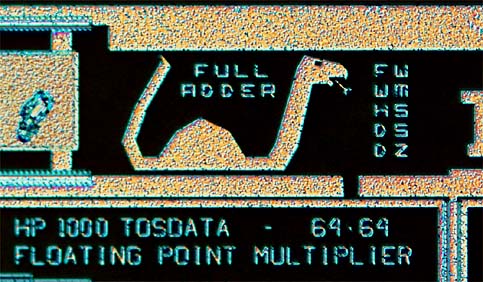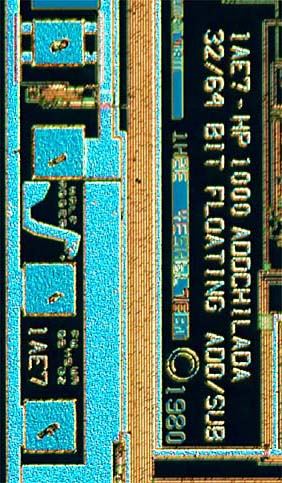

Silicon
...secrets
of our
modern
architects
...revealed
king solomon

Download
these songs.
Yes, I know this page is ugly.

1.
sun dial
This
beautiful rendition of an ancient sundial was discovered near the
clock circuitry on the Hewlett-Packard PA-7300LC microprocessor
that bore the in-house nickname of "VelociRaptor"
and also contains this dinosaur creature on another part
of the chip. HP manager Rick Butler has informed us that the
writing beneath the dial says "VR FP 1995",
which stands for VelociRaptor Floating Point.
We are also told that the sundial was partially covered due to
the metal being placed on different layers during fabrication.
This explains the contrast in definition between the upper and
lower portions of the sundial. HP chip designers chose the
sundial to represent the clock on this chip because it is much
faster than any watch and time does not move in discrete
"ticks".


2. solomon's wisdom


3. full adder
This
cute little snake was found tucked into the pad ring of a
Hewlett-Packard full adder math coprocessor, the HP 1000 Tosdata
64-bit floating point multiplier. The chip is a member of a set
of arithmetic integrated circuits that contain various puns on
addition circuits. The snake was placed onto the chip to
represent the "full adder", a logic circuit that takes
two input numbers and adds them together. There is another chip
in this set that is represented by the "half adder",
another logic circuit that sums two input digits resulting in a
summation with a carry digit. We are told that the half adder
chip contains half a snake, but we haven't been able to locate a
copy of the chip. Just for the record, an Adder is also a
poisonous snake found in Australia and New Guinea.
The full adder chip is interesting for another reason. It is one of the chips that was built by HP using Silicon on Sapphire (SOS) technology in the late 1970s and early 1980s. Below is a discussion by Hewlett-Packard chip designer Willy McAllister on the use of SOS technology, an interesting deviation from everyday silicon wafer-based chips.
 Manufacturing a SOS chip
begins with a sapphire wafer. The chemical composition of
sapphire is aluminum oxide (Al2O3), made
from ions of aluminum and oxygen. In wafer form, sapphire is a
light gray semi-transparent material that is very tough and
rugged.
Manufacturing a SOS chip
begins with a sapphire wafer. The chemical composition of
sapphire is aluminum oxide (Al2O3), made
from ions of aluminum and oxygen. In wafer form, sapphire is a
light gray semi-transparent material that is very tough and
rugged.
Silicon is grown onto the smooth, hard, glass-like surface of the sapphire wafer using epitaxial methods such as Molecular Beam Epitaxy (MBE) or Metal Oxide Chemical Vapor Deposition (MOCVD) where the silicon atoms are assembled one-by-one on the surface of the sapphire wafer. Because the crystal structure of silicon is similar to sapphire, the SOS structure appears to be one crystal with a strong molecular bond between the two materials. The silicon is then patterned into transistors (see our tutorial on Building A Transistor) and the circuit is completed using normal processing.
Initially the SOS technology was developed back in the 1960s for use in military and aviation applications requiring high temperature and "radiation hardened" chips. The main commercial promise of a sapphire substrate is that it has very low capacitance compared to silicon, allowing signals to pass overhead in wires without slowing down. It also allows N- and P- type transistors to be packed closer together, an improvement in density over silicon CMOS (standing for Complementary Metal-Oxide Semiconductor, a MOS circuit formed with both N-channel and P-channel transistor devices). HP took advantage of these features during the evolution from "LSI" to "VLSI" (Large Scale Integration and Very Large Scale Integration) chips in the late 1970s/early 1980s. The math chips and related CPU chips from HP were among the first "VLSI". (a new term at the time)
 Silicon manufacturing
advanced faster than sapphire, and the SOS process faded from use
in commercial applications. It has always maintained a niche in
military applications and has seen a recent surge of interest in
micromachined sensors. There is also a lot of research in the
area of "Silicon-on-Insulator" where the insulator is
silicon dioxide (SiO2, glass) instead of sapphire. SOI processing
stays much closer to the bedrock of silicon technology.
Silicon manufacturing
advanced faster than sapphire, and the SOS process faded from use
in commercial applications. It has always maintained a niche in
military applications and has seen a recent surge of interest in
micromachined sensors. There is also a lot of research in the
area of "Silicon-on-Insulator" where the insulator is
silicon dioxide (SiO2, glass) instead of sapphire. SOI processing
stays much closer to the bedrock of silicon technology.

4. stop following me
Julius
"Groucho" Marx was the most famous of the Marx Brothers
comedy team and eventually wound up with his own television show.
Groucho has now moved into the cyber age with his presence on a
pad woven within the integrated circuitry of the Silicon Graphics
MIPS R12000. This microprocessor chip bears the greatest number
of silicon creatures (six) that we have ever found on a single
chip. The wireframe rendition of Groucho is about 100 microns
high.
for
more information on this phenomenon,
check out the page i stole all these pictures
from without permission.
copyright 1999 IT(tm) Records
The End.